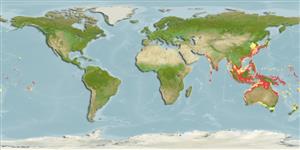Common names from other countries
>
Syngnathiformes (Pipefishes and seahorses) >
Syngnathidae (Pipefishes and seahorses) > Syngnathinae
Etymology: Hippocampus: Greek, ippos = horse + Greek,kampe = curvature (Ref. 45335).
Issue
Junior synonyms Hippocampus dahli Ogilby, 1908 (more studies needed) and H. planifrons Peters, 1877 are considered valid species according to Lourie et al., 2016 (Ref. 115213).
Environment: milieu / climate zone / depth range / distribution range
Ecologia
marino associati a barriera corallina; non migratori; distribuzione batimetrica 0 - 100 m (Ref. 52034), usually ? - 20 m (Ref. 30915). Tropical; 42°N - 42°S, 65°E - 132°W
Indo-West Pacific: India to Tahiti; north to Japan, south to Indonesia.
Length at first maturity / Size / Peso / Age
Maturity: Lm 14.0 range ? - ? cm
Max length : 22.0 cm TL maschio/sesso non determinato; (Ref. 48635)
Spine dorsali (totale): 0; Raggi dorsali molli (totale): 18-22; Spine anali 0; Raggi anali molli: 4.
Inhabits gravel or sand bottoms around shallow reefs (Ref. 559); muddy estuaries and near mangroves, tolerating brackish waters (Ref. 48635). Occur singly or in pairs (Ref. 128523). Ovoviviparous (Ref. 205). The male carries the eggs in a brood pouch which is found under the tail (Ref. 205).
Male carries the eggs in a brood pouch (Ref. 205).
Lourie, S.A., R.A. Pollom and S.J. Foster, 2016. A global revision of the seahorses Hippocampus Rafinesque 1810 (Actinopterygii: Syngnathiformes): taxonomy and biogeography with recommendations for further research. Zootaxa 4146(1):1-66. (Ref. 115213)
IUCN Red List Status (Ref. 130435)
Threat to humans
Harmless
Human uses
Acquacoltura: commerciale
Informazioni ulteriori
BibliografiaAcquacolturaProfilo di acquacolturaVarietàGeneticaElectrophoresesEreditarietàMalattieElaborazioneMass conversion
Strumenti
Special reports
Download XML
Fonti Internet
Estimates based on models
Preferred temperature (Ref.
115969): 24.2 - 29.1, mean 28.3 (based on 622 cells).
Phylogenetic diversity index (Ref.
82804): PD
50 = 0.5000 [Uniqueness, from 0.5 = low to 2.0 = high].
Bayesian length-weight: a=0.00447 (0.00177 - 0.01127), b=3.00 (2.78 - 3.22), in cm Total Length, based on LWR estimates for this (Sub)family-body shape (Ref.
93245).
Trophic level (Ref.
69278): 3.8 ±0.50 se; based on food items.
Resilienza (Ref.
120179): Alto, tempo minimo di raddoppiamento della popolazione meno di 15 mesi (tm=0.5-1).
Fishing Vulnerability (Ref.
59153): Low vulnerability (12 of 100).
